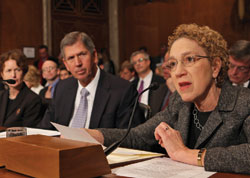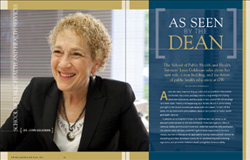As Seen by the Dean
The School of Public Health and Health Services' Lynn Goldman talks about her new role, a new building, and the future of public health education at GW.
A new GW class—representing 45 states and 40 countries—has arrived for the fall; the schools and departments are growing and chasing down new enterprises; and the seeds of new, state-of-the-art buildings have been sown. There's a lot happening here. To help fill you in, we're taking you right to the source in a new Q&A series with GW's deans. To start off the series, we sat down with Lynn Goldman, dean of GW's School of Public Health and Health Services.
A pediatrician and epidemiologist, Dr. Goldman also has served as an assistant administrator for the Environmental Protection Agency's Office of Chemical Safety and Pollution Prevention. Under her watch the EPA overhauled the nation's pesticide laws, expanded right-to-know requirements for toxin release, reached consensus on an approach to testing chemicals with endocrine-disrupting potential, developed standards for implementing lead screening legislation, and promoted children's health and global chemical safety.
Dr. Goldman took over the reins of SPHHS last year and is shepherding the school through a period of transformation: In the past year the top-20 ranked school has leapfrogged its peers, its plans for building a new 115,000-square-foot home have won city approval, and it has welcomed an incoming class that is the school's largest and most work-experienced.
Q How does the new building factor into your vision for the future of the school?
A On an overarching level, I think it will enhance our reputation by having a stronger physical presence—we're already the only school of public health in the nation's capital, but now we'll also be one that's based on Pennsylvania Avenue, down the street from the Capitol.
On a day-to-day level, our school currently doesn't have its own teaching spaces. Because of the way the school was established, the medical students attend classes in the morning and early afternoon, and public health classes fill the same classrooms after. In the new building we'll have much more flexibility to plan our own curriculum, and by design the classrooms will facilitate the use of case studies and group work in teaching.
At the present time Ross Hall doesn't have space for any of our faculty or departments. Faculty offices are scattered in leased spaces around Foggy Bottom, and the faculty migrates to Ross Hall to teach. The separation of our departments is counter to the multidisciplinary nature of public health, in which problems are solved using teams of students and faculty across departments.

Dean Goldman testifies in February before the U.S. Senate Subcommittee on Superfund, Toxics, and Environmental Health, during a hearing on chemical safety laws.
Rick Reinhard
In the new building departments will have their own spaces, while at the same time there will be a fair amount of common space to facilitate those informal encounters between faculty, students, and staff that help to stir the creative juices.
Our new building also presents an amazing opportunity to bring people together, from the federal government and other agencies and nonprofits, which make a difference in health policy on a global scale. While we are already doing this successfully, we can take the whole idea of convening a step further.
Q The class that just entered this fall has some interesting attributes, including that it's nearly 80 percent female. Any idea what's behind that?
A I don't know why it's the case, but it's not just our school. Across the country a majority of public health students are female. I think that it could be in line with some other trends that we've been seeing: Across the country more women are going after not only bachelor's degrees but master's and doctoral degrees.
Maybe public health in particular is attractive to women because it's a field where you have an opportunity to succeed on the basis of merit. I think that public health jobs tend to be pretty gender neutral in terms of your opportunity to be a leader.
Q I've read that your interest in environmental toxins and public health goes back to childhood—seeing strange, luminous hues at night from nearby refineries and plants—and a couple of seismic moments in college: the first Earth Day and the publishing of the first cancer mortality atlas. What's driving students today to public health?
A If it were 10 years ago I would've said 9/11, because we saw an entire cohort of students that came through who became very passionate about public health, as well as public service. And there may be some residual impact of that.
This is a generation that has seen the country at war almost the entire time they've been growing up. Some of them are very interested in health issues related to that. But I would say that what's probably even more important is the interconnectedness that they have with the global community, which is unprecedented. As kids they thought nothing of being online and communicating with other people their age who could be anywhere.
They're connected, but more importantly they're aware of the very serious and desperate health issues that are going on globally: the AIDS epidemic, the people who are starving in Somalia, global climate change.
To some extent we've always been kind of aware of these issues—in my generation maybe Walter Cronkite would've now and then talked about them on the television—but it wasn't a daily, constant sense of awareness, of always being in touch.

A rendering of the recently approved building that will house the School of Public Health and Health Services
Q Where is the school's research strength at the moment, and where do you see it going?
A For a long time we've been strong in health policy and particularly in doing health policy work that involves engagement on a national level: issues like health care quality, community health care clinics, and adolescent health care. We've been a significant leader in those, and I think we'll continue to be a leader in health policy.
I think our challenge in health policy is to become more engaged with academic research. Our new chair of health policy, Paula Lantz, and I have spent a lot of time talking about how we can build a stronger presence for GW in health economics. We're very strong in health law, and policy is about the law; it's about economics; it's about ethics. And even though we're already strong, I think we can be stronger.
We've also had significant growth within research in the area of HIV/AIDS, where last year we received funding from the National Institutes of Health to establish the District of Columbia Developmental Center for AIDS Research (DC D-CFAR).
It's a multi-institutional effort in D.C. to provide leadership and infrastructure for fostering the next generation of HIV/AIDS researchers. The center allows us to develop core research functions that are the building blocks for putting together research projects that, in turn, are funded by the NIH. Already this year, through the center, SPHHS has received $1.5 million in additional research money. So it's a very powerful thing, and another thing that I would call a catalyst for being able to build our efforts.
Q Where else are you looking to grow in theupcoming years?
A I'm hoping we can become more global in our reach. The diversity of our student body is just fantastic, and I expect that our proportion of international students will grow in time. Our location is very important in terms of students from around the world wanting to come here and learn about the science and practice of public health, as well as learn how we deliver public health care in this country and how things work in a democracy. Our international outreach is important not just at the School of Public Health and Health Services but also for the positioning of our university more broadly.
As part of our effort to attract more international students, we need to start exploring how we bring in more students from other countries, either through distance education or crafting short courses on campus.
We also need to travel out of the country and do more work on the ground in other countries. Our school has developed a number of new programs geared toward training students in places like Bangladesh, China, Africa, and India. Next year we're bringing students to Somalia. These study abroad opportunities in public health are very hands-on and are quite different than those provided to undergraduates. With undergraduates we're very careful to make sure they're going to a safe place. In our case, public health students go to some of the more risky countries, where diseases prevail. If you're going to learn how to control malaria, you have to go to a place where there's malaria. And part of what you're learning is not only how to do this but also how to do this without yourself becoming a victim. Our graduates speak very highly of their international experiences and we hope to do more.

